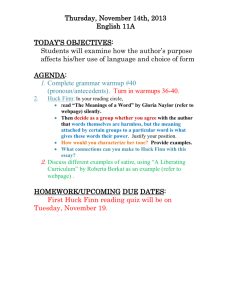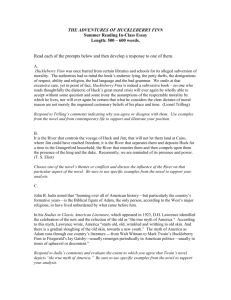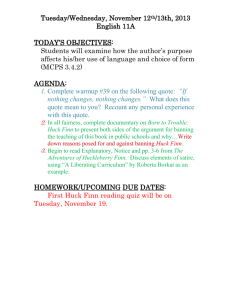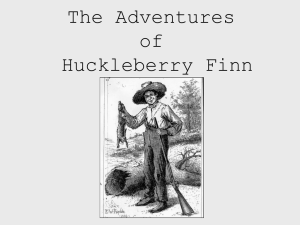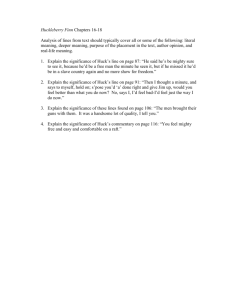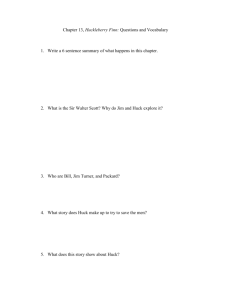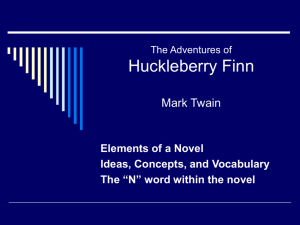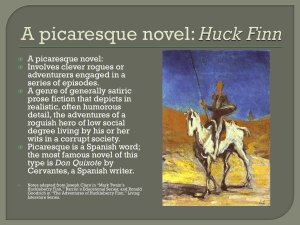ELA 11-12 Huck Finn
advertisement
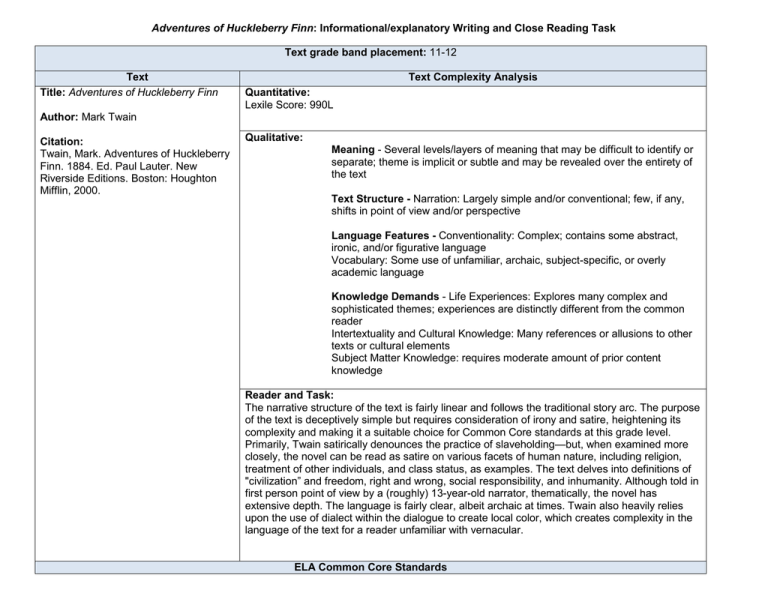
Adventures of Huckleberry Finn: Informational/explanatory Writing and Close Reading Task Text grade band placement: 11-12 Text Title: Adventures of Huckleberry Finn Text Complexity Analysis Quantitative: Lexile Score: 990L Author: Mark Twain Citation: Twain, Mark. Adventures of Huckleberry Finn. 1884. Ed. Paul Lauter. New Riverside Editions. Boston: Houghton Mifflin, 2000. Qualitative: Meaning - Several levels/layers of meaning that may be difficult to identify or separate; theme is implicit or subtle and may be revealed over the entirety of the text Text Structure - Narration: Largely simple and/or conventional; few, if any, shifts in point of view and/or perspective Language Features - Conventionality: Complex; contains some abstract, ironic, and/or figurative language Vocabulary: Some use of unfamiliar, archaic, subject-specific, or overly academic language Knowledge Demands - Life Experiences: Explores many complex and sophisticated themes; experiences are distinctly different from the common reader Intertextuality and Cultural Knowledge: Many references or allusions to other texts or cultural elements Subject Matter Knowledge: requires moderate amount of prior content knowledge Reader and Task: The narrative structure of the text is fairly linear and follows the traditional story arc. The purpose of the text is deceptively simple but requires consideration of irony and satire, heightening its complexity and making it a suitable choice for Common Core standards at this grade level. Primarily, Twain satirically denounces the practice of slaveholding—but, when examined more closely, the novel can be read as satire on various facets of human nature, including religion, treatment of other individuals, and class status, as examples. The text delves into definitions of "civilization” and freedom, right and wrong, social responsibility, and inhumanity. Although told in first person point of view by a (roughly) 13-year-old narrator, thematically, the novel has extensive depth. The language is fairly clear, albeit archaic at times. Twain also heavily relies upon the use of dialect within the dialogue to create local color, which creates complexity in the language of the text for a reader unfamiliar with vernacular. ELA Common Core Standards ELA 11-12.RL.1 Cite strong and thorough textual evidence to support analysis of what the text says explicitly as well as inferences drawn from the text, including determining where the text leaves matters uncertain. ELA 11-12.RL.3 Analyze the impact of the author’s choices regarding how to develop and relate elements of a story or drama (e.g., where a story is set, how the action is ordered, how the characters are introduced and developed). ELA 11-12.RL.5 Analyze how an author’s choices concerning how to structure specific parts of a text (e.g., the choice of where to begin or end a story, the choice to provide a comedic or tragic resolution) contribute to its overall structure and meaning as well as its aesthetic impact. ELA 11-12.W.2 Write informative/explanatory texts to examine and convey complex ideas, concepts, and information clearly and accurately through the effective selection, organization, and analysis of content. ELA 11-12.W.4 Produce clear and coherent writing in which the development, organization, and style are appropriate to task, purpose, and audience. ELA 11-12.W.9 Draw evidence from literary or informational texts to support analysis, reflection, and research. ELA 11-12.SL.1 Initiate and participate effectively in a range of collaborative discussions (one on-one, in groups, and teacher-led) with diverse partners on grades 11–12 topics, texts, and issues, building on others’ ideas and expressing their own clearly and persuasively. What key insights should students take from this text? Correlation between author and character(s) within a text Complexity of characters(s) within a novel Contribution of textual elements (e.g. setting) to the understanding of a work of fiction Contribution of theme(s) to the understanding of a work of fiction Nature of irony and satire Text-Dependent Questions 1. Analytical: How and why does Twain establish Huck’s voice as storyteller? What do we learn about Huck from what he reveals of other characters’ assessments of him? 2. Analytical: Setting is important in establishing a novel and a narrator’s voice. Consider how elements of place are revealed in the opening chapters. How do these elements help develop the voice and characters of Huck, Tom, Jim, and others? 3. Interpretive: Huck often utilizes racial epithets in the novel. Is Huck a racist character? Why or why not? Provide evidence from the text. 4. Interpretive: Consider the feud involving the Grangerfords and Shepherdsons in the novel. In contrast to Jim and Huck, who might be considered part of the lower social classes, these two families hail from a higher class. What is the situational irony in their behavior, as well as other characters in the novel who might be considered “higher class”? 5. Interpretive: Twain's novel has been identified as a "coming of age" novel. As Huck's character matures and grows up, how does his identity change? What stages or phases does he pass through on the way to his new, or more mature, identity? 6. Significance: Identify a moment in the text that is significant to the development of a particular character. Cite evidence from the text to support your claim. 7. Retrospective: Ernest Hemingway claimed that Huck Finn defines American literature and that all modern literature comes from Huck Finn. Do you agree or disagree? What is your rationale? Writing Mode Informational/Explanatory Writing Prompt In what ways is Huck and Jim’s story also the story of America? Analyze the novel, selecting key features (character, plot, theme, irony, etc.) that reflect on 19th century America and the history of our country. Cite textual evidence to support your ideas. Score using the TN informational/explanatory rubric: http://tncore.org/english_language_arts/assessment/scoring_resources.aspx
